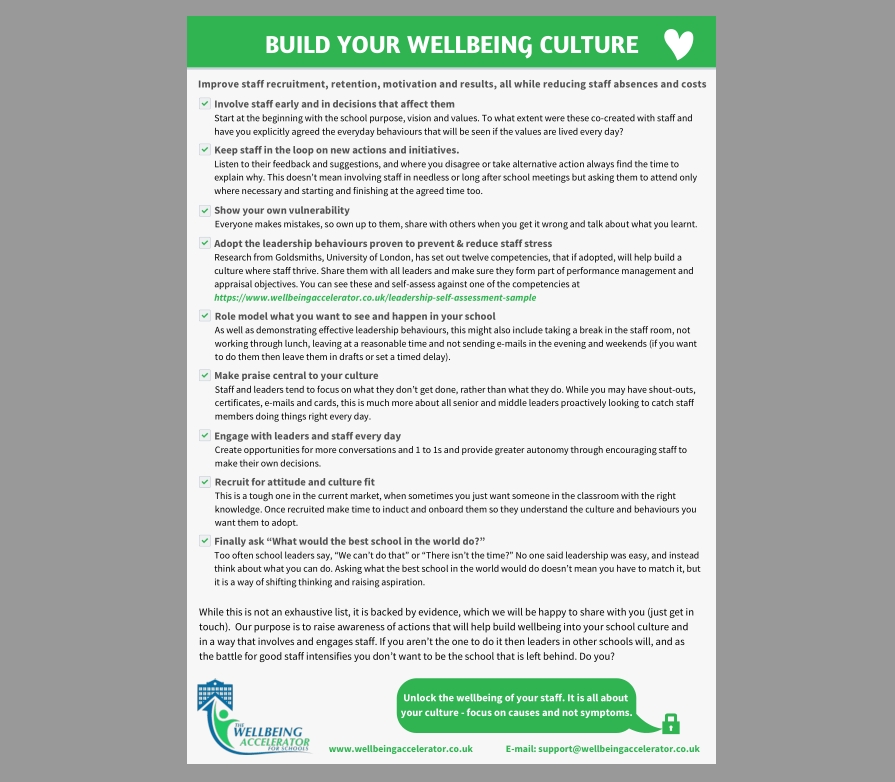Staff wellbeing – What really works?

Never mind throwaway tick-box exercises; true teacher wellbeing means changing some fundamental processes in school and beyond

- by Emma Cate Stokes
- Writer, former teacher and co-founder of EdTech Innovation Hub Visit website

Sick of hearing vague platitudes about quick-fix workshops, or treats in the staffroom? For a real improvement in teacher wellbeing, a more practical approach is required.
Imagine this: it’s a cold Monday morning. Mrs Thompson, a Year 4 teacher, is bustling around her classroom preparing for the day.
She spent most of her Sunday marking books, planning lessons, inputting data and thinking about how to help Toby, a pupil who seems to be struggling with his emotions lately.
At the same time, she’s been grappling with the weight of her wellbeing; she hasn’t seen her friends outside of work for weeks and can’t even spare the time to wash her hair. Sound familiar?
If that narrative strikes a chord with you, you’re likely a teacher in the UK’s highly demanding universe of primary school teaching.
Many of us, when asked, would exclaim without hesitation that primary teaching is unequivocally the best job in the world. And for good reason!
It’s a role where you’re not just a teacher but a mentor, a guide, and often a beacon of hope and inspiration for young, impressionable minds.
The joy of witnessing the ‘light bulb’ moments, the classroom giggles, nurturing young minds and laying down the building blocks for lifelong learning is incomparable.
And yet, behind all that lies a more sobering reality.
Teacher stress
Recent years have seen a noticeable uptick in teacher stress levels, an overburden of administrative tasks, extended work hours, an increase in children’s mental health issues, ever-declining budgets and the eternal struggle of achieving that elusive work-life balance.
So let’s address the elephant in the room – the well-intentioned but often superficial attempts to alleviate these stresses.
Handing out chocolates in the staffroom, or those generic ‘wellbeing’ workshops that are more tick-box than transformative, although a nice idea, are mere short-term fixes.
That hour of ‘mindfulness’ once a month? It’s a welcome break, but it doesn’t solve the root issue.
What teachers truly seek are not mood-lifters but lasting, impactful strategies.
We need tools and systems that don’t just offer temporary solace but reinforce the scaffold of our day-to-day lives. This will make each day more manageable and rewarding.
Below are some ideas you can raise with SLT, as well as smaller steps you can take yourself…
Wellbeing survey
What if, every term, you were handed the microphone in the form of anonymous staff wellbeing surveys? And what if something was actually done with the information?
It’s one thing to listen; quite another to hear, understand, and then pivot accordingly. A proactive approach is far more effective than a reactive one.
For these surveys to truly resonate, two fundamental prerequisites are essential: safety and sincerity.
Staff need to know they’re in a safe space where they can speak candidly, and that they will be listened to.
A dedicated staff meeting should be scheduled to dive into the survey results.
Have an in-depth conversation about the good, the bad, and the steps you’ll take next.
It is an opportunity for the staff to gather, not only as professionals but as allies.
When everyone sees their input shaping decisions and impacting policies, it sends a resounding message: your wellbeing isn’t a footnote; it’s the headline.
Staff wellbeing team
Sometimes after a tough day in the classroom, you need someone who isn’t just going to offer a cup of tea and a chat (though those help) but can provide real, actionable strategies.
Trending
Here’s where a school’s dedicated staff wellbeing team steps in. It symbolises more than just a title on a door or a monthly meet-up.
They are a particular group of individuals equipped to offer more than just kind words.
This team should be a patchwork quilt of the school’s community, stitched together by members from every part of the institution.
While including a senior leader might seem tempting, their absence might actually be the key.
While broader issues or emerging patterns can be shared with the SLT, the specifics of who said what – barring any critical safeguarding concerns – must remain guarded, ensuring the safety of the space.
The wellbeing team should be well-versed in the nuances of mental health, the art of communication, and the strategies to support their peers effectively. So training is a must.
They aren’t simply colleagues; they are lifelines, ensuring every staff member knows they’re not alone and their wellbeing is a top priority.
Marking policy
Rather than trudging through deep marking 30 books for every subject – which can sometimes mean over 120 books a day – how about embracing methods that genuinely serve you and your pupils?
Imagine harnessing the power of collective feedback, where you address common misconceptions, and praise shared achievements.
Gone would be the days of writing the same comment repeatedly. Instead, you’d have a system that communicates effectively and saves time.
And speaking of time-savers, have you ever tried verbal feedback instead of those long comments?
Wouldn’t it be great to be in a classroom where students actively engage in the feedback process, eagerly absorbing your insights and immediately applying them, rather than waiting to read what you’ve written?
Let me tell you from experience; it works a lot better with a class of Year 2s than comments in books!
Boundaries for wellbeing
The vibrant bustle of school corridors often sees teachers juggling multiple responsibilities. In this challenging sphere, you must master the art of tactfully saying ‘no’.
The blurred lines between the demands of teaching and personal life can sometimes make you feel you’re in an endless loop of acquiescing to every request.
Yet, there’s power in understanding your limits.
When faced with an additional task, a strategy I have found really effective is to respond with a proactive approach. “Of course, I’d be willing to help with that. However, I’m currently operating at capacity. Could you suggest which of my existing tasks I could set aside to accommodate this?”
This response is transformative for several reasons.
First, it conveys willingness and a positive attitude, showing that you are not opposed to assisting, but are mindful of your workload.
Secondly, it places the ball back in the requester’s court, prompting them to consider your current commitments and the feasibility of the new task.
It encourages a re-evaluation of priorities. Lastly, it fosters a culture of open dialogue about workload and capacity, emphasising that every staff member’s time is valuable and finite.
At the end of the day, while gestures like staffroom cake are well-intentioned, it’s the systematic changes that show teachers’ time is truly valued that really make a difference.
Emma Cate Stokes is a freelance writer and former primary teacher. Follow Emma on X (formerly Twitter) @emmccatt










